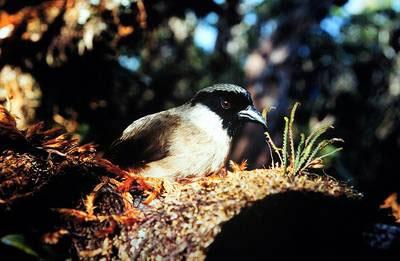Po'o-uli (Melamprosops phaeosoma) - Wiki Po'o-uli
From Wikipedia, the free encyclopedia
[Photo] Po`o-uli (Melamprosops phaeosoma)
The Po'o-uli or Black-faced Honeycreeper (Melamprosops phaeosoma) is an endangered bird that is endemic to Hawai'i. It is considered to be a member of the Drepanidinae (Hawaiian honeycreeper) subfamily, and is the only member of its genus Melamprosops. The vernacular name (often erroneously spelled "po'ouli", "poouli", "po'o'uli", "pouli" or "poo-uli") means 'dark head' and refers to the bird's characteristic feature, a black 'bandit' mask. This is no original Hawaiian term; in fact, whether there was a native name as for many endemic birds of these islands is not known.
The po'o-uli wasn't discovered until 1973 by students from the University of Hawai'i, who found the bird on the north-eastern slopes of Haleakala on the island of Maui. It feeds mostly on snails, insects, and spiders and nests in native 'ohi'a forests.
It is believed that there are now at most two remaining individuals of this species, down from an estimated 200 when the species was first discovered. The dramatic population decline has been attributed to a number of factors, including habitat loss; mosquito-borne diseases; predation by pigs, rats, cats, and mongooses; and a decline in the native tree snails that the po'o-uli relies on for food.
Both of the two remaining birds are at least ten years of age, nearing the end of their life, and probably have not been fertile since a few years. It is uncertain whether they are a male and female pair or both of the same sex, or even if they are still alive.
In 2002, a female was captured and taken to a male's home range in an attempt to get them to breed. The female, however, had flown back to her own nest, which was a mile and a half away, by the next day. There was also a ten-day expedition which was scheduled to begin on April 27, 2004. The goal of this was to capture all three birds, and bring them to a bird conservation center on the island in the hope they would produce offspring.
On September 9, 2004, a male po'o-uli was captured and taken to the Maui Bird Conservation Center in Olinda, in an attempt to captively breed the bird. However, biologists could not find a mate for the male before it died of avian malaria on November 28, 2004. Biologists are now searching for the two remaining birds, which have not been seen for over a year and are probably dead too.
Tissue samples have been taken from the male for possible future cloning, but as neither birds of the opposite sex are now available nor natural behavior can be imprinted on possible cloned individuals, this does not seem probable. As such efforts would likely compete with conservation funding of extant bird species, it may not even be desirable as a cloning attempt would both be highly likely to fail and at the same time jeopardize the survival of other highly threatened species. The 2006 paper by VanderWerf et al. wraps up the conservation issues regarding the po'o-uli; the species is uplisted from Critically Endangered to Probably Extinct in the 2007 IUCN Red List.
http://en.wikipedia.org/wiki/Po%CA%BBo-uli
| The text in this page is based on the copyrighted Wikipedia article shown in above URL. It is used under the GNU Free Documentation License. You may redistribute it, verbatim or modified, providing that you comply with the terms of the GFDL. |
